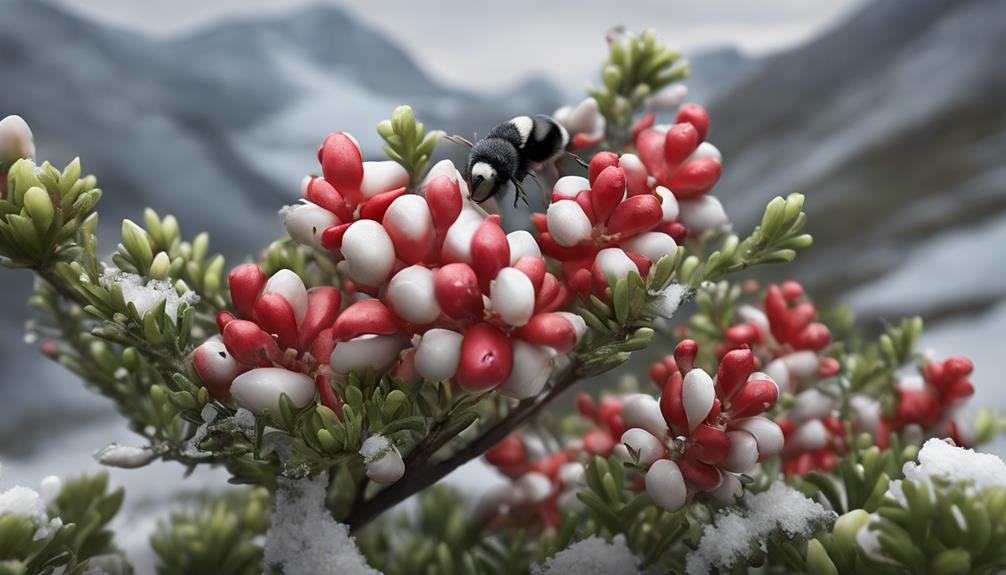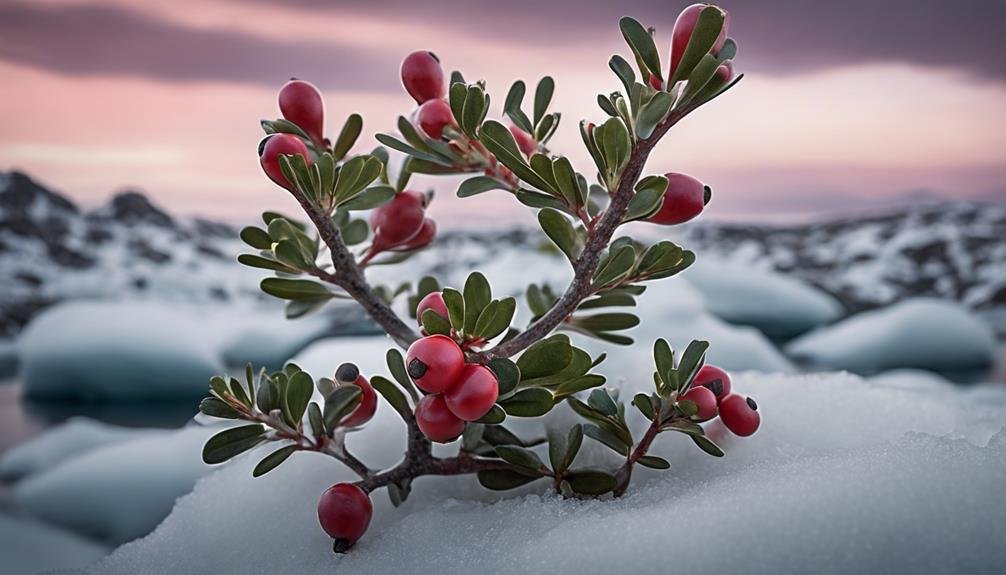Why does Bearberry (Arctostaphylos Uva-Ursi) stand out in the plant kingdom? This resilient groundcover is not only a survivor in harsh environments but also a vital component of its ecosystem. Bearberry thrives in poor soil conditions and extreme climates, making it a fascinating subject for both scientific study and horticultural appreciation. Its ability to provide food for birds and habitat for butterflies adds to its ecological importance.
In the broader context, Bearberry serves as a prime example of plant adaptability and ecological contribution. Its dense foliage and the ability to change color with the seasons showcase nature’s intricacy in survival and beauty. Yet, this hardy plant faces challenges from habitat and climate changes, highlighting the need for focused conservation efforts. Understanding the vulnerabilities and strengths of Bearberry can offer insights into larger environmental dynamics and inform strategies to protect our natural world.
Key Takeaways
Bearberry (Arctostaphylos uva-ursi) plays a crucial role in environmental ecosystems, supporting biodiversity and health. Its ability to prosper in diverse conditions, including harsh Arctic-Alpine regions, highlights its resilience. The plant attracts pollinators and provides sustenance for wildlife, emphasizing its importance in ecological networks. Yet, the threat to its habitats demands immediate conservation efforts to ensure its survival and the well-being of its ecosystem.
Key Takeaways:
- Bearberry is an evergreen plant essential for attracting pollinators and feeding various wildlife, which helps sustain biodiversity.
- It flourishes in a wide range of environments, particularly in the challenging climates of Arctic-Alpine regions, showcasing its adaptability.
- The plant’s habitats are increasingly at risk, stressing the need for conservation actions to protect Bearberry and its ecological contributions.
Bearberry Overview
Resilient and Low-Maintenance: Bearberry’s Ground Cover Excellence
Bearberry, known scientifically as Arctostaphylos uva-ursi, is a remarkable evergreen shrub that shines in its role as ground cover. Its ability to flourish in challenging conditions, combined with its visual appeal, renders it an indispensable element in various landscapes. The shrub’s green leaves aren’t only visually attractive but also signify its ecological adaptability. With the arrival of colder weather, these leaves may transition to a bronze hue, introducing a seasonal variation to its appearance while continuing to provide effective ground coverage.
Drought Tolerance: Bearberry’s Adaptability
A standout feature of bearberry is its exceptional drought tolerance. This characteristic is especially useful in areas emphasizing water conservation or in settings that demand low-maintenance landscaping solutions. Bearberry’s resilience in sandy and rocky soils, often where moisture is scarce, highlights its robustness and flexibility as a ground cover choice. This inherent drought resistance, paired with its evergreen quality, guarantees that bearberry offers a consistent and appealing ground cover solution year-round, adapting effortlessly to various weather conditions without sacrificing its aesthetic or functional value.
Low-Growing Evergreen Shrub

Growth and Habitat
This low-growing evergreen shrub creates a thick ground cover, achieving heights between 6 and 12 inches while spreading out to a width of 3 to 6 feet. It prospers in the challenging conditions of infertile, sandy, acidic soils, making it a perfect plant for rock gardens and open woodland areas. Throughout the year, its glossy dark green leaves transform into a purplish bronze during winter, offering a striking visual transformation that captivates the onlooker’s interest from season to season.
Drought Resistance and Flowering
Remarkably resilient, the shrub exhibits excellent drought tolerance, which, combined with its aesthetic appeal, makes it a versatile addition to various garden styles. In the heart of spring, it’s adorned with lantern-shaped flowers that vary in color from white to pink. These blooms aren’t only visually appealing but also play a significant role in supporting local wildlife, attracting butterflies and bees and thereby enhancing the biodiversity of the area.
Ecological Impact and Berry Production
Post-flowering, the shrub bears bright red berries. While not particularly palatable to humans due to their lack of flavor, these berries are a vital winter food source for birds and mammals. This aspect underscores the plant’s ecological value, providing sustenance to wildlife during the colder months when food is scarce.
Global Arctic-Alpine Presence

Resilience of Bearberry in Arctic-Alpine Regions
In the frigid environments of Arctic-Alpine areas, the bearberry, or Arctostaphylos uva-ursi, stands out for its remarkable ability to endure. These regions are known for their extreme conditions, including high altitudes and rocky terrains, yet bearberry thrives, showcasing its adaptability.
Soil Stabilization and Erosion Control
One of the key roles of bearberry in these ecosystems is its contribution to soil stabilization. The plant’s root system binds the soil effectively, reducing erosion. This is particularly vital in Arctic and alpine landscapes, where soil is precious and maintaining its integrity is necessary for the survival of various species.
Contribution to Biodiversity and Ecological Balance
Bearberry’s presence in Arctic-Alpine regions isn’t just about survival; it’s about enriching the ecosystem. During winter months, its colorful berries add vibrancy to the otherwise stark landscape, offering essential nutrients to local wildlife. Through supporting diverse life forms, bearberry plays an integral part in maintaining ecological balance.
Supporting Wildlife and Sustaining Ecosystems
The significance of Arctostaphylos uva-ursi extends to the support it provides to various organisms. By offering habitat and food, bearberry aids in sustaining the complex web of life unique to Arctic-Alpine ecosystems. This interconnectivity highlights the importance of bearberry in these regions, underpinning the broader ecological network.
Each aspect of bearberry’s existence in Arctic-Alpine regions—from its resilience to its ecological functions—underscores the interconnectedness and the intricate balance of life in these challenging environments.
Pollinator Attraction Mechanism

Pollinator Attraction: A Deep Dive into Bearberry’s Allure
Bearberry, with its bell-shaped pink and white flowers, stands as a beacon for pollinators in its ecosystem. These flowers aren’t just a feast for the eyes but also a vital source of nectar and pollen for butterflies, bees, and hummingbirds. The significance of these pollinators can’t be overstated, as they play a pivotal role in the reproduction of the bearberry and maintain the ecological equilibrium of their habitat.
The fragrant aroma that these flowers emit acts as a magnetic pull, drawing in a variety of pollinators. This olfactory invitation, coupled with the visual charm of the bearberry blossoms, crafts an efficient pollinator attraction mechanism. The presence of diverse pollinators around bearberry plants enriches the biodiversity and ensures a balanced ecosystem.
Bearing Fruits of Biodiversity Through Pollinator Hosting
Hosting an array of pollinators, bearberry plants are cornerstones in their ecological niches. The long bloom season of bearberry ensures that pollinators have a steady source of food across spring. This not only aids in the survival of these crucial pollinators but also fortifies the plant’s reproductive success.
In essence, bearberry’s contribution to its environment extends beyond its immediate survival. By attracting various pollinators, it enhances the biodiversity and fosters a robust ecological network. The relationship between bearberry and its pollinators exemplifies nature’s interconnectedness and the importance of each species in sustaining ecological harmony.
Vulnerable Habitats

Threats to Bearberry Populations
Bearberry faces a precarious future due to ongoing urban development and the consequences of climate change. These forces are transforming its natural habitats, making survival increasingly difficult. Urban expansion, coupled with the spread of agriculture and deforestation, significantly diminishes the living spaces and vital resources Bearberry plants depend on.
Concurrently, climate change exacerbates these challenges, altering essential environmental conditions such as temperature and rainfall patterns. These alterations can disrupt the intricate ecological relationships critical to bearberry vitality, rendering thriving communities susceptible.
The Challenge of Invasive Species
Yet another hurdle for bearberry comes from invasive species, which fiercely compete with it for sunlight, nutrients, and water. This intense rivalry can severely impact bearberry’s ability to grow and reproduce, diminishing its strength in native habitats. Overgrazing by herbivores, especially deer, further compounds the problem by directly feeding on bearberry plants, thus impeding their recovery and spread.
Conservation Efforts for Bearberry
In response to these mounting threats, conservation initiatives are crucial. They strive to shield endangered bearberry habitats and secure the species’ continued existence. Tackling the issues posed by urbanization, climate change, invasive species, and overgrazing, these conservation measures are vital for preserving the environments on which bearberry, and the broader ecosystem relying on it, depend.
Through these efforts, habitats are maintained not only for bearberry but also for the small mammals that find food and shelter within these spaces.
Frequently Asked Questions
What Is Arctostaphylos Uva-Ursi Used For?
Q: What is the use of Arctostaphylos uva-ursi?
A: Arctostaphylos uva-ursi is primarily used to promote urinary tract health due to its antimicrobial properties, helping to prevent and fight infections. It is also valued for its skin benefits, including its ability to lighten the skin and serve as an astringent, thereby supporting both internal and external health.
Is Uva Ursi the Same as Bearberry?
Q: Are Uva Ursi and Bearberry the same plant?
A: Yes, Uva Ursi and Bearberry are the same plant known for their traditional medicinal applications. However, there are toxicity concerns with Uva Ursi. The plant is also popular for its use as ground cover, adding to its versatility in garden landscapes.
How Big Do Arctostaphylos Uva-Ursi Get?
Q: How tall and wide can Arctostaphylos uva-ursi grow?
A: *Arctostaphylos uva-ursi* typically reaches a height of 6-12 inches and can spread up to 3-6 feet wide. It prefers well-drained sandy soils and usually does not require pruning due to its slow, mat-forming growth habit.
Is Uva Ursi the Same as Kinnikinnick?
Is Uva Ursi the same as Kinnikinnick?
Yes, Uva Ursi and Kinnikinnick refer to the same plant. These terms highlight the plant’s significance in various cultures and its adaptability to different environments.
What Are the Key Differences Between Bearberry and Crowberry in Terms of Their Uses and Benefits?
Bearberry and crowberry differ in their primary uses and benefits. Bearberry is commonly used for urinary tract health due to its antibacterial properties, while crowberry is known for its rich antioxidant content. Among the crowberry health benefits are improved cognitive function and its potential to fight inflammation and oxidative stress.
What Are the Differences in Nutritional Benefits Between Bearberry and Cloudberry?
Bearberries are rich in antioxidants and have anti-inflammatory properties, mostly used in traditional medicine. In contrast, cloudberries are packed with vitamin C, fiber, and ellagic acid, boosting immunity and digestion. The cloudberry plant benefits include its ability to improve skin health and provide a strong source of healthy nutrients.
Conclusion
Bearberry (Arctostaphylos uva-ursi) stands out as a vital element within different ecosystems, contributing significantly to environmental health. Its adaptability, evidenced by its evergreen nature and widespread presence in Arctic-Alpine regions, allows it to thrive in a variety of conditions.
The plant is instrumental in attracting pollinators and serving as a food source for various wildlife species, thereby playing a key role in maintaining biodiversity. However, the increasing vulnerability of its natural habitats underscores the urgency of implementing conservation measures.
Recognizing the ecological value of Bearberry is paramount for its protection and the overall sustainability of the environments it inhabits.


